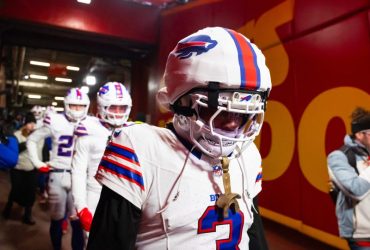A recent filing in connection with the upcoming court hearing concerning final approval of the proposed multi-billion-dollar settlements of three athlete-compensation antitrust cases against the NCAA and the Power Five conferences expressed concerns about what name-image-and-likeness (NIL) agreements among schools and athletes will look like if the settlement is approved.
It also provided a window on what those agreements generally may look like: lengthy, granting the schools wide-ranging use of athletes’ NIL and placing some significant limitations on the athletes.
Technically, the filing asks U.S. District Judge Claudia Wilken for permission to submit for her consideration a friend-of-the-court (or, amicus) brief — a commentary on the case by an interested third party. It came from lawyers for Athletes.org, Inc., an organization that described itself in the filing as an entity that “exists to educate, organize and represent college athletes as their chosen players association to ensure that their interests are protected as college athletics continues to evolve.”
But in addition to seeking permission to file the amicus brief, the organization filed the brief and supporting exhibits that included documents described as templates of NIL agreements written by the Big Ten and Southeastern conferences and from the universities of Arizona, Kansas and Minnesota. The document attributed to Arizona does not include any specific school or conference name.
The SEC confirmed to USA TODAY Sports the authenticity of the submitted template, although spokesman Herb Vincent said in a statement: ‘After discussion several months ago about whether we should consider adopting a conference-wide NIL agreement template, this document was submitted to our schools as a draft for review but no action was taken to adopt it.’
It is unclear whether any SEC schools have used any parts of the template as a basis for their agreements, and, in any case, the template includes a footnote on its first page that reads: “This agreement includes various sample provisions, almost all of which are negotiable, and this sample agreement should be carefully reviewed and revised to fit the specific needs and terms of the applicable parties.”
The Big Ten said in a statement it “does not verify documents submitted to a court by other parties.” In response to an open-records request from USA TODAY Sports after the filing, Minnesota provided the current version of its document — and it tracks, but does not fully replicate, the document the filing attributed to the Big Ten.
Kansas and Arizona did not respond to inquiries about the documents respectively attributed to them.
NIL deals said to already exist
The presumptive amicus brief says — and the supporting exhibits indicate — that schools already have been putting agreements in place with athletes, with a proviso that they would become void if the proposed settlement does not receive final approval.
The presumptive brief says that Athletes.org, Inc., “supports this proposed settlement as an initial step in the right direction of addressing long-standing injustices that have existed within college athletics … but that does not mean, from AO’s perspective, that the proposed settlement should be approved” because the group has “grave concerns,” including about NIL contract provisions that it says “prevent athletes from objecting to this settlement.” The document that the group’s lawyers said is from Arizona is specific on this point, stating: “To the extent Student Athlete objects to the Settlement, the Agreement shall become null and void.”
The organization called these agreements “contracts … drafted by those with superior bargaining strength, that relegates to college athletes only the opportunity to adhere to these contracts, or reject them.”
It is unclear from the filing whether an athlete with sufficient negotiating leverage could bargain for changes to any of the terms.
In addition, while the filing asks Wilken to “clarify several key points so as to ensure that this settlement is not misconstrued as a comprehensive and final solution for college athletics,” Wilken wrote in an order March 4 that she “cannot order changes to the agreement” and “objectors should address whether they wish the Court to reject the settlement and set the case for trial.”
Wilken granted preliminary approval to the proposed settlements in October. She is set to hold a final-approval hearing on April 7 concerning the agreements, which would include nearly $2.8 billion in damages that would go to current and former athletes over 10 years. They also would allow Division I schools to start paying athletes directly for use of their name, image and likeness (NIL) during the 2025-26 school year, subject to a per-school cap that would increase over time and be based on a percentage of certain athletics revenues.
Some of the specific terms in NIL agreements
Those payments would be made under contracts that seem certain to be extensive. The SEC’s “license agreement” template included 12 pages of terms. Those attributed to the Big Ten and Arizona were 10 pages apiece. The two-page draft “letter of intent and term sheet” attributed to Kansas referenced “a Long-Form Agreement” that was not included in Athletes.org, Inc.’s filing.
Confidentiality
The agreements have some common elements, including detailed confidentiality requirements for the athletes. Minnesota’s “Memorandum of Understanding,” as provided by the school to USA TODAY Sports says that without the school’s prior written approval, the athlete cannot disclose any details except to parents, guardians, attorneys or “other competent representatives.” The requirements would remain in place for five years after the agreement’s termination.
Broad NIL use
An “Annex” to the Minnesota MOU says the athlete “grants the Institution the right to use and sublicense Athlete’s NIL to promote the Institution, the Conference, and/or the NCAA and/or such entities’ respective third party partners, sponsors, affiliates and sublicensees in any way … ’’
Athletes’ outside NIL deals cannot conflict with schools
The term sheet represented to have come from Kansas, in a condition that exists similarly in other documents, states that athletes cannot have an NIL deal with an entity that competes with its sponsors and that when engaging in activities on KU’s behalf, they agree “to wear adidas clothing unless specific attire is required.”
Pay can be changed
The Minnesota MOU says athletes’ pay “may be subject to regular review and assessment at Institution’s discretion.”
This differs in specificity from what was represented as the Big Ten MOU template, which, in two places, offers the following language: “The Consideration is a projected amount based on the current promotional value of using the Athlete’s NIL. The Institution in its discretion may, at any time, adjust the Consideration to reflect an increase or decrease in the Athlete’s NIL value (e.g., a Heisman Trophy win may increase the NIL value and reduced playing time may decrease the NIL value).’
Addressing pay for play
The Minnesota document does follow what was represented as the Big Ten template in saying that the parties agree that the pay “is not provided in exchange for the Athlete’s commitment to attend the Institution or participate in the Institution’s program (i.e., not ‘Pay-for-Play’).” Elsewhere the Minnesota document states, also in alignment with what was represented as the Big Ten template, that “if the Athlete enters the NCAA’s transfer portal or transfers, the Institution will have no further obligation to pay the Athlete …” and that “notwithstanding any other provision of law or agreement to the contrary,” the athlete agrees that he or she “is not, and shall not claim to be, an employee of the Institution.”
Buyout option
The document attributed to Arizona includes as “optional” language the terms for a buyout that could be required of an athlete who transfers during the term of the agreement. If included in a deal, it would prevent the athlete from making an NIL deal from another school unless the athlete – or the subsequent school, on the athlete’s behalf – pays “a buyout amount equal to fifty percent … of the remaining NIL Payments that would have otherwise been due” to the athlete during the remainder of the agreement’s scheduled term.
This is similar to language that is included in most contracts that schools have with coaches.




